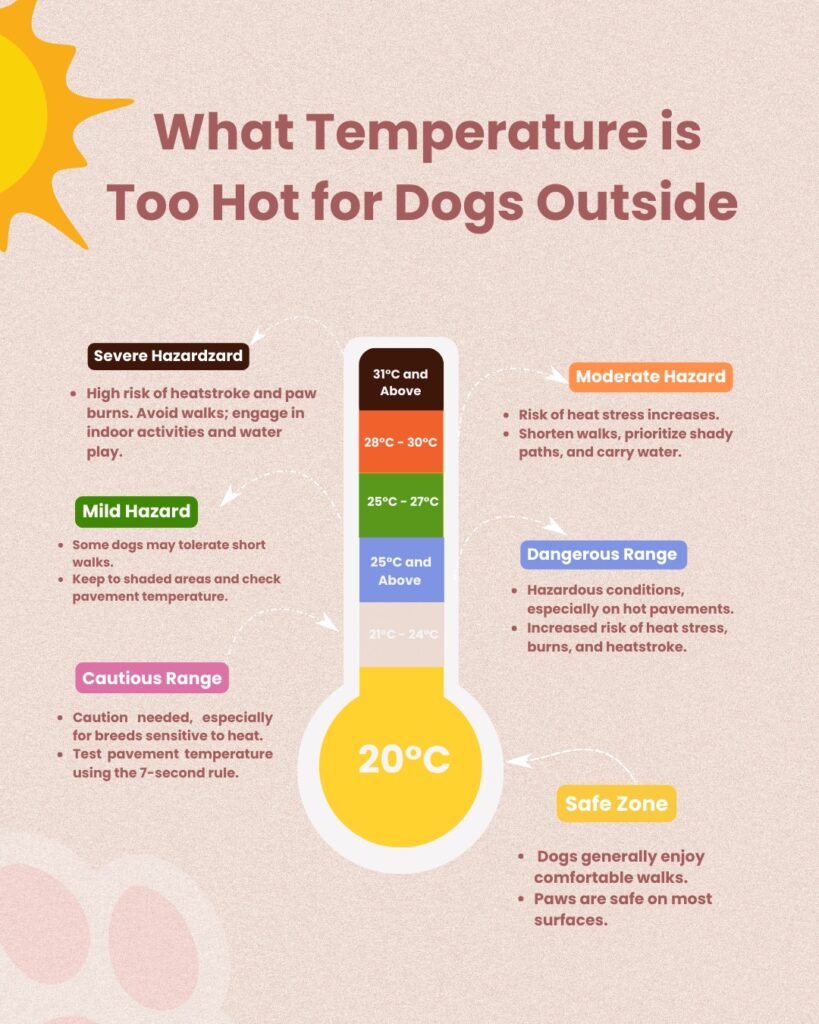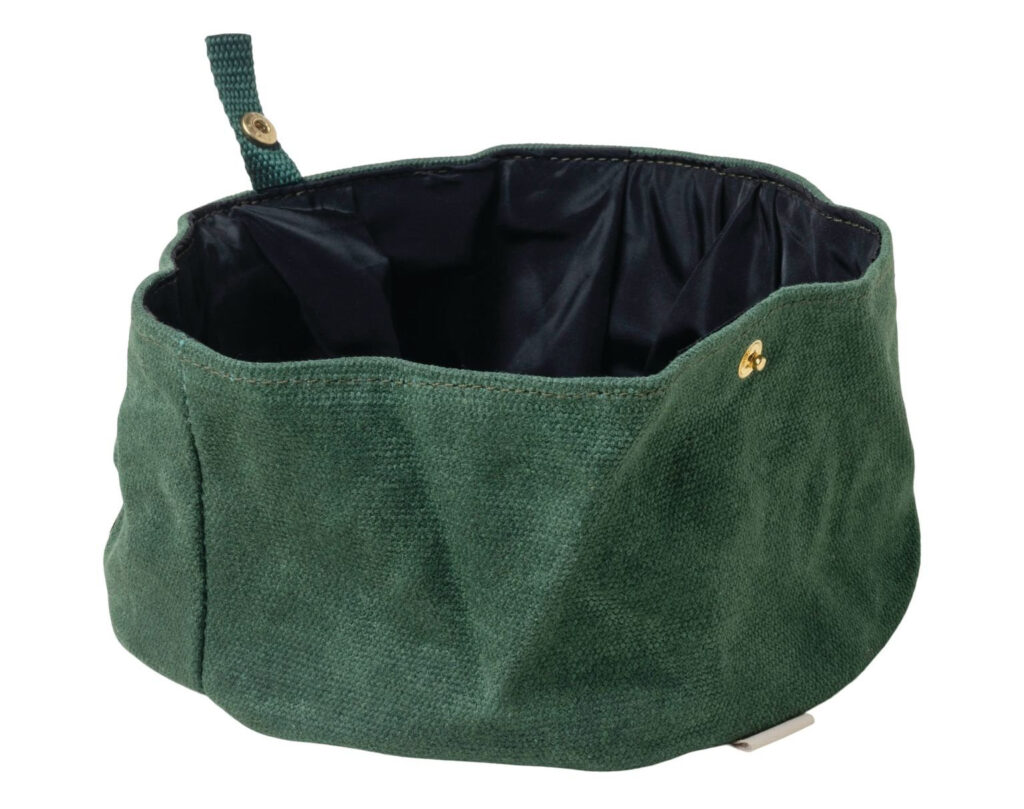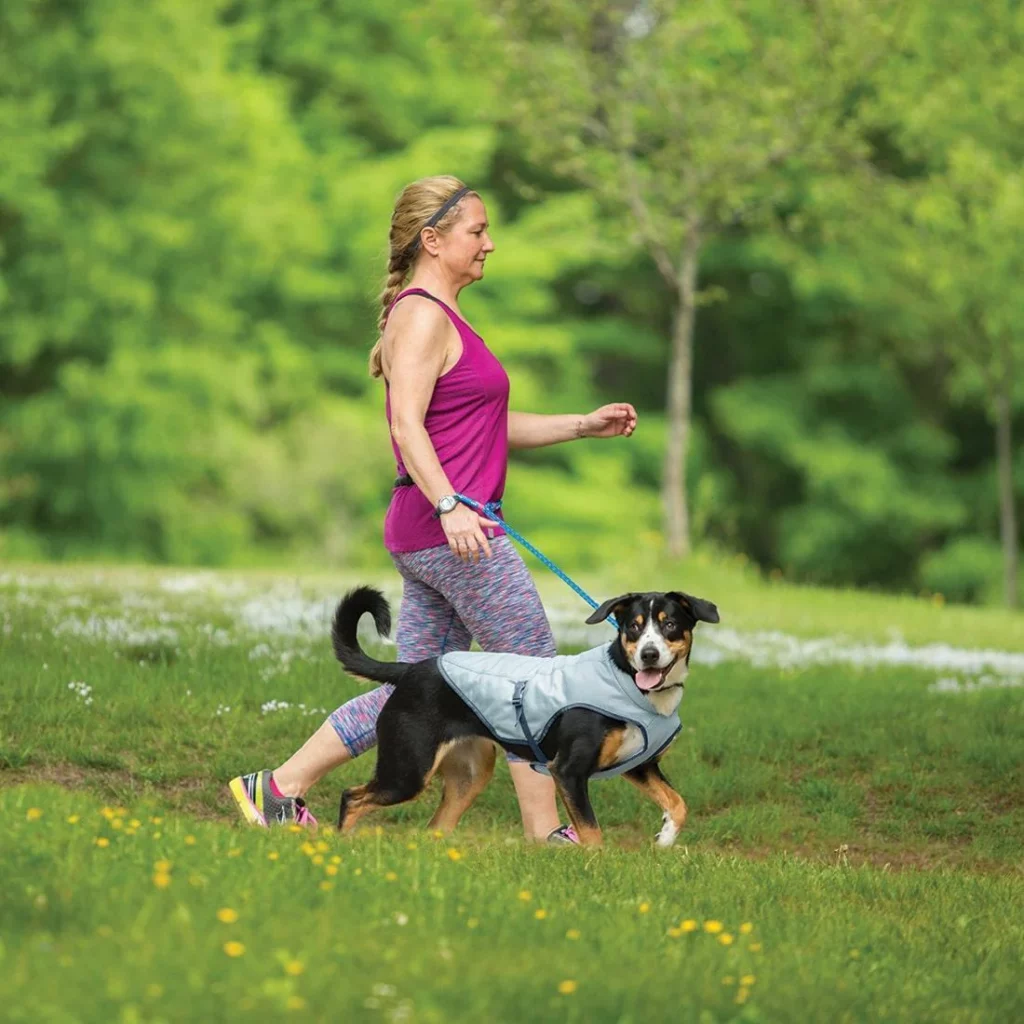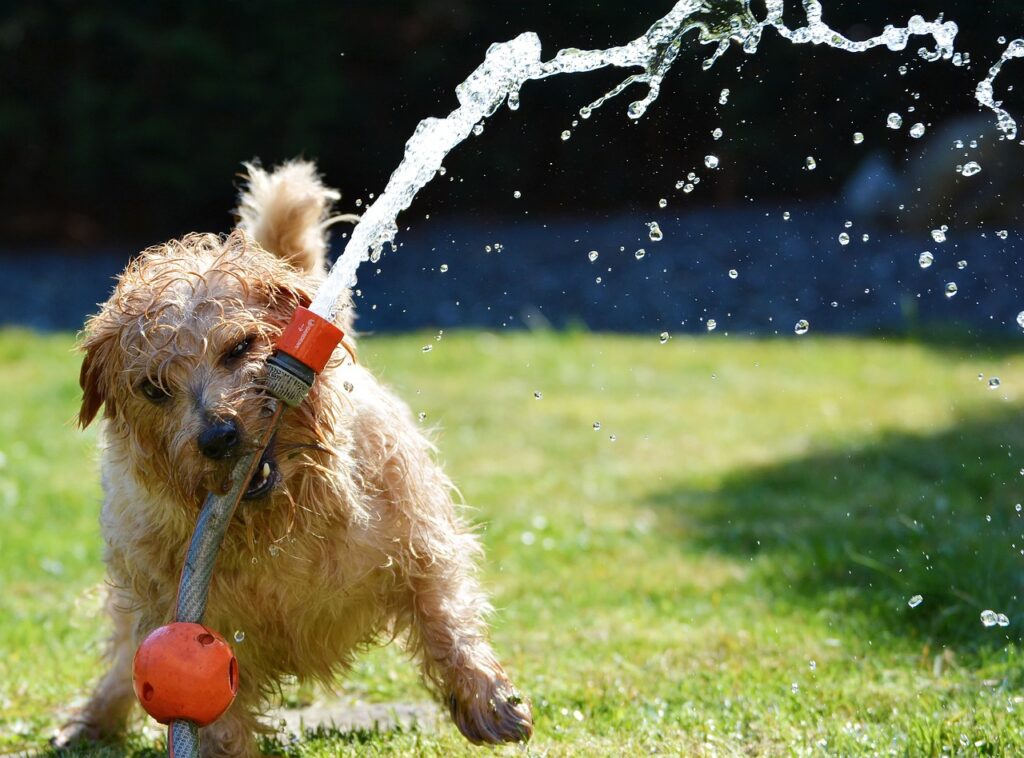Welcome to the sizzling topic of walking your dog in the heat! As the mercury rises, so do our concerns about keeping our furry friends cool. It’s not just about splashing in the waves or finding shade; it’s about knowing when the temperature is too hot for those four-legged trotters.
Walking your dog is essential for their health, but in the scorching heat, it can be risky. Understanding the right time and temperature for a safe stroll is crucial to avoid any hot water – or rather, hot pavement – situations.
Let’s dive into the nitty-gritty of temperature guidance, the signs of overheating, and how to keep your cool canine even cooler. We’ll ensure your pup’s walk is more about fun and less about the sun!
Contents
- 1 Walking Your Dog in the Heat
- 1.1 The Quick Answer
- 1.2 Understanding Your Dog’s Heat Tolerance
- 1.3 The “7-Second Rule” and Other Quick Tests
- 1.4 The Best Times of Day for Summer Dog Walks
- 1.5 What Temperature is Too Hot for Dogs Outside
- 1.6 Recognising Signs of Overheating in Dogs and Cooling Measures
- 1.7 Tips for Keeping Your Dog Cool During Walks
- 1.8 Understanding Your Dog’s Limits in the Heat
- 1.9 Alternatives to Outdoor Walks on Hot Days
- 1.10 Myths vs. Facts: Understanding Dogs and Hot Weather
- 1.11 FAQs: Navigating the Heat with Your Dog
- 2 Conclusion: Happy Tails and Safe Trails
Walking Your Dog in the Heat
The Quick Answer
An easy rule to follow is it’s it’s 20 degrees or below, you should be fine to take your dog for a walk. Anything above, and it’s time to enjoy some indoor activities until it cools down.
But there is more to the story, so we’ll dive into a comprehensive guide to walking your dog in the heat below:
Understanding Your Dog’s Heat Tolerance
Heat Sensitivity in Different Dog Breeds

Brachycephalic breeds, such as Bulldogs and Pugs, face unique challenges in hot weather due to their short nasal passages. These breeds struggle with efficient breathing, making heat dissipation more difficult. As a result, they are more prone to overheating even in moderately warm temperatures. It’s crucial for owners of these breeds to be extra cautious during summer months and avoid prolonged exposure to heat.
Age and Health Factors in Heat Tolerance
Puppies and senior dogs have a harder time regulating their body temperature compared to adult dogs. Their underdeveloped or aging bodies can’t cope with extreme temperatures as effectively. Similarly, dogs with underlying health issues, especially those related to breathing or heart problems, are at a higher risk during hot weather. These dogs should be kept cool, and their outdoor activities should be limited on hot days.
Recognising Signs of Heat Stress in Dogs
It’s vital to recognise the signs of heat stress in dogs to prevent heatstroke. Common symptoms include:
- Excessive Panting and Drooling: These are initial signs of heat stress. Panting is a dog’s way of cooling down, but excessive panting indicates that the dog is struggling to reduce its body temperature.
- Lethargy: If your dog seems unusually tired, unresponsive, or less enthusiastic about activities they normally enjoy, it might be a sign of overheating.
- Uncoordinated Movements: Watch for any signs of dizziness or lack of coordination, as these can indicate heat exhaustion or the onset of heatstroke.
By understanding these aspects of your dog’s heat tolerance, you can take appropriate measures to ensure their safety and comfort during hot weather. Remember, preventing heat stress is always easier than treating it, so stay vigilant and proactive in keeping your furry friend cool.
The “7-Second Rule” and Other Quick Tests
The 7-Second Rule: A Simple Test for Safe Walking Temperatures
The “7-Second Rule” is an easy and effective way to check if the pavement is too hot for your dog’s paws. Here’s how to do it:
- Place the back of your hand against the pavement and hold it there for 7 seconds. The back of your hand tends to be more sensitive to temperatures than the palm of your hand, so is a good indication of how the surface will feel like for your furry friend’s paws.
- If it’s too hot for your hand, it’s too hot for your dog’s paws. The heat that feels uncomfortable to your skin is likely to be even more intense for your dog’s more sensitive paws.
This test is a quick way to assess the risk before taking your dog out for a walk. It’s especially useful in urban areas where concrete and asphalt can heat up quickly under the sun.
Additional Methods to Test Pavement Temperatures
- Infrared Thermometers: For a more precise measurement, consider using an infrared thermometer. These devices can provide an exact surface temperature reading, helping you make a more informed decision about walking your dog.
- Understanding Surface Heat: Different surfaces absorb and radiate heat differently. For example, concrete can get hot but usually not as hot as asphalt, which can retain more heat. Grass, on the other hand, is typically cooler and safer for your dog.
Variability of Surface Temperatures
Sometimes the surface outside your front door may not be the only surface you will walk on so it’s important to understand how each surface can heat up.
- Grass: Grass tends to be the coolest of all the surfaces on a hot day. So if the pavements and walkways are too hot, maybe you can jump in the car and head to the dog park with your furry friend for a play session instead.
- Sand: On hot days, it might be tempting to run down to the beach. However, how many times have you run down to the beach on a hot day, only to get to the sand, and it feels like it’s going to burn your feet and you have to put your things on to walk down to the sea? The sand tends to heat up quickly on hot days, so check it before you ask your furry friend to hopscotch all the way down to the sea.
- Concrete Surfaces: While concrete gets hot under the sun, it’s usually cooler than asphalt. If you must walk your dog in hot weather, try to stick to concrete pathways or sidewalks.
- Asphalt and Other Surfaces: Asphalt can get dangerously hot and can even cause burns on your dog’s paws. Always test asphalt with the 7-second rule before allowing your dog to walk on it.
By using the 7-second rule and understanding the different heat-retaining properties of surfaces, you can better protect your dog’s paws during hot weather. Always prioritise your dog’s safety and comfort to ensure enjoyable and safe walks, no matter the temperature.
The Best Times of Day for Summer Dog Walks
Timing is Everything: When to Walk Your Dog in Summer
Choosing the right time for your dog’s walk during summer is crucial for their well-being. To avoid the harsh midday heat, the best times are early in the morning or later in the evening. This is when the sun is less intense, and the temperatures are generally cooler. Morning walks can be a refreshing start to the day for both you and your furry companion. Evening walks, as the sun sets, provide a cooler and more comfortable environment, ensuring a pleasant experience for your furry friend.
Considering Australia’s Diverse Climate
Australia’s vast landscape means that the climate can vary significantly from one region to another. In cooler regions, midday walks might still be comfortable, while in hotter areas, it’s best to strictly avoid walks during peak heat hours. Being aware of your local climate and weather forecasts is essential. For instance, in places like Darwin, where humidity combines with heat, even early morning or late evening walks require extra precautions.
Utilising a Dog Walk Temperature Chart

A Dog Walk Temperature Chart can be a handy tool to guide you. This chart typically categorises temperatures into safe, cautious, and danger zones for dog walks. Here’s how to use it:
- Safe Zone: This range indicates temperatures where it’s generally safe to walk your dog. However, always consider your specific dog’s needs and tolerance.
- Caution Zone: In this range, you should be careful with walks. Shorten the walk duration and carry water. Look out for signs of heat stress.
- Danger Zone: This indicates temperatures that are too high for safe walks. Avoid walking your dog in these conditions to prevent heatstroke and paw burns.
By understanding and utilising these guidelines, you can ensure that your walks with your dog are both enjoyable and safe throughout the summer. Remember, keeping your furry friend cool and comfortable is the key to a happy and healthy season together.
What Temperature is Too Hot for Dogs Outside
Understanding the Temperature Scale for Dog Safety
When it comes to walking your furry friend, not all temperatures are created equal. It’s essential to know when the heat crosses from being merely uncomfortable to downright dangerous for your dog. Generally, temperatures around 20 degrees Celsius are considered safe, but as the mercury climbs beyond this, especially above 25 degrees Celsius, the risk of heat-related issues increases significantly. It’s a good idea to closely monitor your dog for any signs of discomfort as temperatures rise.
Is 25 Degrees Celsius Too Hot for a Dog Walk?
At 25 degrees Celsius, the heat can start to affect your dog, depending on their breed, age, and health condition. While some dogs may still enjoy a leisurely walk at this temperature, it’s crucial to take precautions like walking in shaded areas, avoiding hot pavements, and ensuring your dog is well-hydrated. Remember, each dog is unique, so keep a close eye on how your pooch responds to these conditions.
Gradual Acclimatization to Warmer Temperatures
Just like humans, dogs need time to adjust to temperature changes. Gradually acclimating your dog to warmer temperatures can help prevent heat stress. Start with shorter walks in the cooler parts of the day and slowly increase the duration as your dog becomes more comfortable. Always have water on hand and watch for signs of overheating (and don’t forget your eco-friendly dog poop bags). This way, you and your pup can enjoy the sunshine without getting too hot under the collar!
By keeping these points in mind, you can help ensure that your dog stays safe and comfortable, even as the temperature rises. Always err on the side of caution, and remember, if it feels too hot for you, it’s probably too hot for your furry friend too! Let’s keep those tails wagging safely in the summer heat.
Recognising Signs of Overheating in Dogs and Cooling Measures
Understanding and Responding to Heatstroke in Canines
Heatstroke in dogs is a critical condition caused by a significant increase in body temperature. It can be life-threatening and demands immediate attention. While dogs have natural cooling mechanisms like panting, these can be insufficient in high temperatures or during intense activities.
Symptoms of Heatstroke and Cooling Measures
- Mild Symptoms: Look for signs like excessive panting, drooling, and increased heart rate. If these symptoms appear, move your dog to a cooler area, provide water, and apply cool (not cold) water to their body. Avoid ice or extremely cold water as this can shock their system.
- Moderate Symptoms: Red gums, lethargy, disorientation, and increased thirst indicate that the situation is getting more serious. Continue applying cool water, and use fans to aid in cooling. Offer small amounts of water to drink, and contact your vet for further guidance.
- Extreme Symptoms: In severe cases where vomiting, diarrhea, seizures, or collapse occur, seek emergency veterinary care immediately. While waiting for help, continue cooling efforts gently.
Cooling Down Your Dog
If your dog shows signs of overheating, it’s crucial to start cooling them down gradually. Use room temperature water to wet their fur and skin, provide a fan for air circulation, and encourage them to drink small amounts of water. For more detailed advice on keeping your dog cool, check out our blog post on how to keep your dog cool in the heat.
By understanding the signs of heatstroke and knowing how to respond, you can greatly reduce the risk of serious complications. Remember, prevention is key, and being aware of your dog’s condition during hot weather can ensure their safety and well-being.
Debunking Misconceptions About Dogs and Heat
A common misconception is that dogs can always self-regulate their body temperature. While dogs have some natural mechanisms to cool down, they can be overwhelmed in extreme conditions. It’s a fur-paw to think that all dogs can handle high heat just because they’re animals. As responsible pet parents, it’s up to us to keep an eye on the thermometer and our furry friends to ensure they stay cool and comfortable. Remember, when in doubt, it’s better to err on the side of caution and provide a cool retreat for your panting pal.
Tips for Keeping Your Dog Cool During Walks
Choosing the Right Gear for Cool Comfort
When preparing for a summer walk with your furry companion, selecting the right gear is as important as picking the right trail. Lightweight, reflective harnesses or vests can make a significant difference. These specialised accessories reduce heat absorption and reflect sunlight away from your dog’s body. It’s like giving your dog their very own shade tree to walk under!
Hydration: A Must-Have on Every Walk

Water is the elixir of life, especially during those pant-tastic summer walks. Always bring along a portable water bottle or collapsible bowl for your dog. Offering regular water breaks not only keeps them hydrated but also helps regulate their body temperature. It’s like having a portable water fountain for your parched pup!
The Magic of Cooling Mats and Vests

For those extra-hot days, cooling mats or dog cooling vests can be a game-changer. These innovative products are designed to keep your dog’s body temperature down. Cooling vests work by evaporation technology, and mats provide a refreshing surface for your dog to lie on during breaks. It’s like giving your dog their personal air conditioner!
By incorporating these tips, you’ll ensure that your dog stays as cool as a cucumber, even on the warmest days. Remember, a comfortable dog is a happy dog, and that means more tail-wagging adventures for both of you!
Understanding Your Dog’s Limits in the Heat
Misconceptions About Dogs Stopping When Too Hot
It’s a common belief that dogs will simply stop moving or show clear signs when they get too hot. However, this isn’t always the case. Dogs, especially those that are highly motivated or eager to please, might continue to push themselves despite being overheated. They often don’t understand their limits and rely on their owners to monitor their well-being. It’s crucial to remember that by the time a dog shows obvious signs of heat distress, they may already be in a dangerous situation.
The Role of Owner Vigilance
As a dog owner, being vigilant about your dog’s behaviour and the outdoor temperature is essential. On hot days, monitor your dog closely for any signs of discomfort. Adjust the intensity and duration of their exercise accordingly. Always be proactive rather than reactive when it comes to dealing with heat. It’s far better to prevent overheating in the first place than to have to treat it after it occurs.
Preventive Measures to Keep Your Dog Safe
- Plan Ahead: Check the weather forecast before heading out and choose the coolest times of day for your walks.
- Watch for Signs: Keep an eye out for excessive panting, reluctance to move, or any unusual behaviour.
- Know Your Dog: Understand your dog’s breed, age, and health status to assess their risk level in hot weather.
By being proactive and attentive, you can ensure your pup stays safe and enjoys their time outdoors, even on warmer days. Remember, when it comes to heat, it’s always better to err on the side of caution and keep those tails wagging safely!
Alternatives to Outdoor Walks on Hot Days
Creative Indoor Games for Your Pooch
When the heat outside becomes unbearable, it’s time to get creative indoors. Engaging your dog in indoor games is not only a great way to beat the heat but also to keep their minds active and bodies fit. Games like hide-and-seek, where you hide and call your dog to find you, or treat puzzles that challenge them to solve problems for a reward, can provide hours of entertainment. These activities aren’t just fun; they’re a fantastic way to strengthen the bond between you and your furry friend.
Water Play: A Refreshing Alternative

For dogs who love water, setting up a small, supervised paddling pool or turning on a sprinkler can create a mini-oasis for them. This allows your dog to cool off while enjoying some light play. Remember to supervise all water activities to ensure your dog’s safety. It’s like having a mini water park for your pooch!
Mental Stimulation: Keeping the Mind Sharp
Don’t forget the importance of mental stimulation. Interactive toys, training sessions, or simple DIY agility courses using household items can keep your dog mentally engaged. These activities not only prevent boredom but also help maintain your dog’s cognitive health. It’s a brain workout for your dog that’s both enriching and entertaining.
For more ideas on indoor activities, check out our blog post on indoor dog summer activities. Remember, there are plenty of ways to keep your dog active and cool without stepping outside. Let your imagination run wild, and enjoy these fun-filled indoor adventures with your canine companion!
Myths vs. Facts: Understanding Dogs and Hot Weather
Debunking Common Myths
In the dog world, myths about hot weather can lead to misunderstandings and potentially harmful practices. Let’s set the record straight:
- Myth: Dogs Can Tolerate Heat Just as Humans Can.
- Fact: Dogs process heat differently than humans. Their primary cooling method is panting, which isn’t as efficient as sweating. This difference makes them more susceptible to overheating.
- Myth: If My Dog Is Panting, They’re Cooling Down Effectively.
- Fact: While panting is a cooling mechanism, excessive panting can be a sign of overheating. It’s important to recognise when panting indicates distress.
- Myth: Shaving My Dog’s Coat Will Help Them Stay Cooler.
- Fact: Dogs’ coats are designed to regulate their temperature. Shaving them can actually make it harder for them to stay cool and can expose them to sunburn. It’s better to give them a brush instead.
What Temperature is Too Hot to Walk a Dog?
Generally, temperatures above 25 degrees Celsius can be unsafe, especially on hot pavement. Always perform the 7-second rule before heading out.
How to Test if It’s Too Hot to Walk Your Dog?
The 7-second rule is a quick and easy test. If you can’t keep your hand on the pavement for 7 seconds, it’s too hot for your dog.
What Temperature is Too Hot to Walk Dogs in Australia?
In Australia, temperatures above 25 degrees Celsius can be risky for dog walks, especially in direct sunlight or on hot surfaces.
Is it OK to Walk a Dog in 30 Degree Weather?
It’s best to avoid walking your dog in 30-degree weather, especially during peak sun hours. If you must, choose shaded areas and keep the walk short.
Conclusion: Happy Tails and Safe Trails
Knowing when it’s too hot to walk your dog is essential for their safety and well-being. With these tips and insights, you’re equipped to make informed decisions for your furry friend’s summer adventures.
Stay vigilant about the heat, and always prioritise your dog’s comfort. Remember, a cool dog is a happy dog!
Have you found creative ways to keep your pooch cool? Share your experiences and tips in the comments or on social media. Let’s keep our canine companions safe and happy in the sun.






0 Comments